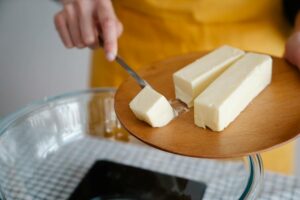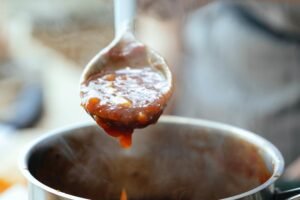Hot sauce is the epitome of spicy food. Hitting your taste buds with zesty tasty flavor, it makes consuming a meal a walk in the park.

However, beginners may find hot sauce unpleasant, thanks to the high capsaicin levels. It can leave you with watery eyes and a sweaty body.
To mitigate this, you can use butter. Butter helps reduce the hotness of the pepper, allowing you to enjoy your chicken wings or cauliflower wings. But what more does adding butter to the sauce do? Let’s find out.
What Adding Butter to Hot Sauce Does
Butter is a savory addition that not only bolsters the hot sauce’s flavor but also does the following:
Balances ‘Heat’ And Flavor
One of the chief reasons to add butter to hot sauce is to counteract the hotness that is hot sauce. Hot sauce contains capsaicin, a compound that determines the ‘heat’ you’ll feel when using the sauce.
Carolina Reaper has a rating of 1,400,000 – 2,200,000 SHUs, while bell pepper has a 0 SHUs rating. This means hot sauce with the former will have more ‘hotness.’
So, to mellow out the burning sensation in your mouth, you can add butter.
It is especially ideal when preparing dishes such as buffalo wings for a wide range of audiences. The butter and hot sauce combination provides a more harmonious and less overwhelming flavor.
Creates a Creamy Texture
Do you want to add a tasteful creaminess to your hot sauce? Well, unsalted butter is the perfect option. You don’t want to use salted butter as this will result in a briny sauce, which is not that appealing to the taste buds.
When you mix the sauce with the butter, you get a velvety-smooth, buttery sauce that clings to your chicken or cauliflower wings, creating a delightful mouthfeel.
Not only is the texture tasty but also visually appealing, making your dishes more satisfying.
Thickens The Sauce

When added in the right portions, butter transforms the hot sauce from a thin and fiery liquid to a thick sauce that can be used in different dishes.
If you want to coat your dish, whether buffalo wings or Doritos casserole, hot sauce with butter will definitely do the trick.
In addition, it is an ideal option for marinating your dishes. You can use it to strike a balance between creaminess and hotness, enhancing the flavor of your dish.
Enables Customization
Another reason to use butter with hot sauce is to allow for customization. It allows you to tailor the dish to your liking.
Whether you want it thick or thin, butter will help you achieve this. Furthermore, you can experiment with the ratio of butter to hot sauce, allowing you to find the perfect balance of creaminess and spiciness.
While at it, you can experiment with different types of butter. While most people use unsalted butter, you can give salted butter a try.
For example, you can use garlic-infused butter with chipotle hot sauce for a rich, fiery flavor.
Bolsters the Aroma
Adding butter does not only bolster the texture and taste of your sauce but also the aroma.
As you’d expect, butter has a distinctive aroma that when combined with other dishes, elevates the sensory experience of the dish at hand.
And this is the same case when you use it with hot sauce. It makes it more appealing, thanks to the mouthwatering aroma of the butter.
Why Temperature Is Crucial When Adding Butter to Hot Sauce
Adding butter at the right temperature is crucial to achieving a consistent texture. Since butter is solid at room temperature, it needs to melt and incorporate seamlessly with the hot sauce.
As such, you need to heat the butter and sauce to the right temperature before mixing them.
Otherwise, you’ll get an uneven and lumpy mixture, or even worse, an oily sauce. Temperature also determines the texture and consistency of the mixture.
For a thick sauce, the butter needs to be warm enough to melt seamlessly. For a thin option, you want to add the butter when at room temperature.
Temperature also affects the flavor of the sauce. When the butter melts at the ideal temperature, it can integrate seamlessly with the hot sauce, allowing its flavors to blend easily.

How to Add Butter to Hot Sauce
- Add ½ stick of butter to a cup of hot sauce.
- Turn the burner on and set it to the lowest setting.
- Slowly whisk the butter every few minutes to ensure even distribution.
- The butter will eventually melt, giving you a velvety texture.
- You can now add other ingredients such as sugar, vinegar, and salt, making sure to mix thoroughly for a smooth and even blend.
Which Type of Butter Should You Use in Hot Sauce?
There are two main types: unsalted and salted butter. You don’t want to add more saltiness to an already hot ingredient.
As such, you should opt for unsalted butter. Using salted butter will only amplify the flavor, which, as you’d guess, is not inviting.
Unsalted butter has a neutral flavor, allowing you to enjoy all the spicy notes in your hot sauce. Furthermore, you get to enjoy the rich flavor that is butter.
It also allows you to control the amount of salt you use in each recipe.
And if customization is your thing, unsalted butter got you sorted. You can add as much or as little salt as you deem pleasing. Besides, you can opt for other sources of salt.
Thanks to its low sodium levels, most chefs consider it a healthier option.
Whether you want to prepare sriracha mayo, Diablo sauce, or Buffalo sauce, you can never go wrong with unsalted butter.
What Are Alternatives to Butter?
If you don’t have access to butter, don’t fret, you can use the following alternatives:
- Ghee is an ideal option as it is lactose-free, fatty, and lower in sodium. It is especially popular with Asian hot sauces. Keep in mind that ghee has more fat content than butter. So if you are looking for a nutty flavor, try ghee.
- Sunflower is ideal if you are looking for a dairy-free option. Like butter, it has a neutral flavor that blends well with the hot sauce. This fantastic oil is also healthy thanks to the monounsaturated and polyunsaturated fatty acids.
Don’t have butter? Well, ghee and sunflower will still do the trick. You can also opt for coconut or avocado oil.
Final Thoughts
As you can see, adding butter to your hot sauce not only gives it a neutral taste but also gives it a creamy texture.
Thanks to its high-fat content, it envelopes the spiciness that is pepper. And when using the butter, choose the unsalted option.
Not only is it low in sodium but also has a neutral flavor, which blends well with hot sauce. So, whether you are into New Mexico-style, Chile Tabasco, or Texas Pete sauce, adding butter will help lower the ‘heat’ level of the pepper.
